Stellations
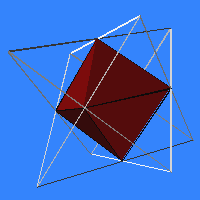 Depending
on how the face planes of a given polyhedron divide space, there may be
several ways to extend them and choose regions which they bound. Starting
with an octahedron, stellation produces
only one possibility: the compound
of two tetrahedra (stella octangula). This model shows two
tetrahedra in outline; their face planes are generated by extending
the faces of the inner octahedron.
Depending
on how the face planes of a given polyhedron divide space, there may be
several ways to extend them and choose regions which they bound. Starting
with an octahedron, stellation produces
only one possibility: the compound
of two tetrahedra (stella octangula). This model shows two
tetrahedra in outline; their face planes are generated by extending
the faces of the inner octahedron.
Observe that two planes which meet at an edge of the stellation will
not share an edge of the inner polyhedron. So there are no stellations
of the cube --- nonadjacent faces are parallel,
and so never meet to form a finite solid.

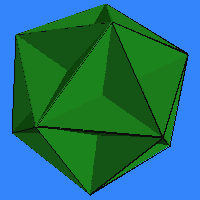
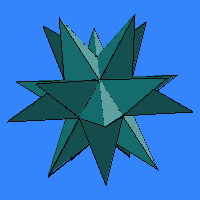
Starting with the dodecahedron, the
three stellations possible: the small
stellated dodecahedron, the great
dodecahedron, and the great
stellated dodecahedron are shown above. In that order, each is
a continuation of the face planes of the previous one. These three stellations
fall within the class of Kepler-Poinsot
polyhedra. Try flying inside them to find the inner dodecahedron in
each.
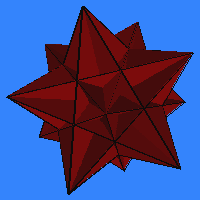 The
remaining Kepler-Poinsot solid, the great
icosahedron, is a stellation of the icosahedron. Travel inside this
great icosahedron to find its inner icosahedron.
Starting with the icosahedron, it turns out that there are 59 possible
stellations, of which the great icosahedron is only one. To learn about
the others, read about the 59
Stellations of the Icosahedron.
The
remaining Kepler-Poinsot solid, the great
icosahedron, is a stellation of the icosahedron. Travel inside this
great icosahedron to find its inner icosahedron.
Starting with the icosahedron, it turns out that there are 59 possible
stellations, of which the great icosahedron is only one. To learn about
the others, read about the 59
Stellations of the Icosahedron.
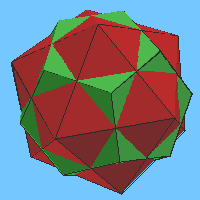 The
first stellation of a convex quasi-regular
solid is a compound of two dual regular solids. For example, the first
stellation of the cuboctahedron is
the compound of the cube and
octahedron. The first stellation of the icosidodecahedron
is the compound of
the icosahedron and the dodecahedron.
The
first stellation of a convex quasi-regular
solid is a compound of two dual regular solids. For example, the first
stellation of the cuboctahedron is
the compound of the cube and
octahedron. The first stellation of the icosidodecahedron
is the compound of
the icosahedron and the dodecahedron.
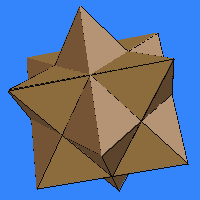 There
are three stellations of the rhombic
dodecahedron:
There
are three stellations of the rhombic
dodecahedron:
- The first stellation of the rhombic dodecahedron, illustrated at right, shows up in popular take-apart puzzles and is an interesting space-filling solid. Notice how similar it is to the compound of three octahedra; just change the shape of each triangle in the compound slightly from equilateral (i.e., reduce the altitudes of the square dipyramids) to get the stellation. Both show up in the work of M.C. Escher.
- The second stellation can be seen as a compound of four flat rhombic parallelepipeds. (Each with its 3-fold axis aligned with a 3-fold axis of the original rhombic dodecahedron.)
- The third stellation can be seen as a compound of six tetragonal disphenoids, very similar to the rigid compound of 6 tetrahedra; again only a slight change in triangle shape from equilateral is necessary to obtain the stellated rhombic dodecahedron.
You can also read about the many stellations of the cuboctahedron, stellations of the rhombic triacontahedron, stellations of the triakis tetrahedron, and tetrahedral stellations of the dodecahedron.